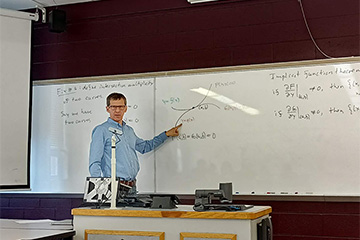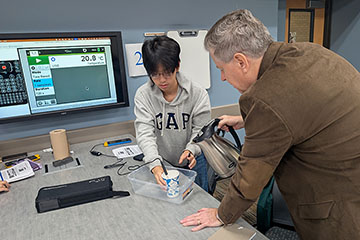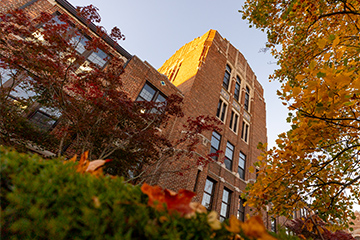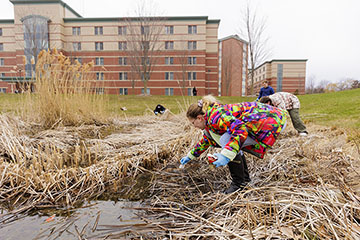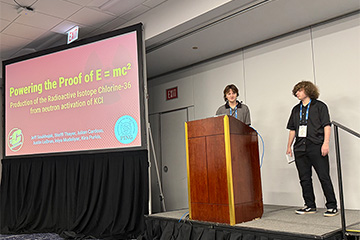On the Waters of Discovery: The Research Journey of Carmine Sabatini
Carmine Sabatini (they/them), an undergraduate researcher from Central Michigan University, spent this past summer at the forefront of an ambitious, NSF-funded scientific endeavor—one that would take them across the Great Lakes aboard the RV Blue Heron (a research vessel), alongside scientists from the University of Michigan, Michigan State University, the University of Minnesota Duluth, and Central Michigan University. Led by primary investigators Dr. Chappaz (Central Michigan University) and Dr. Hardisty (Michigan State University), the mission sought to collect sediment cores from the lakebeds of Erie, Huron, and Superior, a task crucial to understanding the long-term impact of climate change on one of Earth’s most significant freshwater ecosystems.
For Sabatini, this wasn’t just a chance to contribute to climate research. It was a moment of personal and academic discovery, a pivotal step on their journey to becoming a scientist. What began as an opportunity to gain field experience quickly became a test of endurance, patience, and determination as they worked to uncover the mysteries buried deep within the sediment layers of the Great Lakes.
Into the depths of the Great Lakes
 Over the course of the expedition, Sabatini and their team ventured to six distinct sites across the three lakes, using state-of-the-art tools to collect water and sediment samples. They deployed a CTD casting machine to gather water from various depths and employed a combination of piston and gravity corers to extract sediment cores from the lakebeds—some reaching more than 10 meters in length. These long sediment cores were the prize of the expedition, as they offered a historical record stretching back thousands of years.
Over the course of the expedition, Sabatini and their team ventured to six distinct sites across the three lakes, using state-of-the-art tools to collect water and sediment samples. They deployed a CTD casting machine to gather water from various depths and employed a combination of piston and gravity corers to extract sediment cores from the lakebeds—some reaching more than 10 meters in length. These long sediment cores were the prize of the expedition, as they offered a historical record stretching back thousands of years.
For Sabatini, the intricacies of the process were fascinating. The collection of the long cores involved complex coordination, careful handling, and precise equipment. Each core, once brought aboard, had to be processed immediately. "The sediment holds invaluable geochemical data," they explained. "We had to ensure the samples were preserved properly, using gloveboxes filled with nitrogen to prevent contamination from the air." Even the porewater from the sediments—water trapped between particles—was carefully extracted using rhizons and syringes, providing further data to be analyzed later.
A deeper purpose
But the real question remained—why was this research so important?
The Great Lakes, which collectively hold 21% of the Earth’s freshwater, are more than just a natural wonder. They are vital to the health and wellbeing of the millions who rely on their waters. Climate change, combined with human activity, is placing these ecosystems under increasing strain. The sediment cores Sabatini and their team collected offered a window into the past—data from as far back as 10,000 years, preserved anaerobically in the lakebeds. By analyzing the geochemical markers in the sediment, scientists hope to refine models predicting future climate impacts on the region, providing crucial information to help protect this invaluable resource.
For Sabatini, being part of this mission was deeply rewarding. "The work we’re doing is essential. The data we gather will inform how we protect the Great Lakes from the effects of climate change, and that’s something I’m incredibly proud of."
Life on the expedition
The expedition, however, was not without its challenges. Days began early, sometimes at 6 a.m., and often didn’t end until well after midnight. The team worked around the clock, sampling the lakebeds as soon as they arrived at each site, regardless of the time. The only exception? Long core sampling, which could only be done safely in daylight.
Despite the physically demanding schedule, Sabatini thrived on the boat. The sense of accomplishment they felt after a long day of work far outweighed the exhaustion. "There were days where I’d go to bed at 2 a.m. and get up at 6 a.m., but I didn’t mind. I was proud of how much we accomplished each day."
Mealtimes, prepared by Lisa—the boat’s chef and medical officer—offered a brief respite. Sabatini often spoke of Lisa’s upbeat attitude and incredible cooking, which helped keep spirits high on even the most challenging days. During quieter moments, when the boat was traveling between sampling sites, Sabatini would sit on the deck, watching the changing waters of the Great Lakes pass by, reflecting on the remarkable differences between Erie, Huron, and Superior. "It was amazing to feel the temperature drop as we moved north. By the time we reached Superior, we were bundled up in coats, a far cry from the shorts and T-shirts we wore at the start."
But more than the research or the scenery, it was the connections Sabatini made with their fellow researchers that left a lasting impact. Spending weeks on a boat in close quarters, working together toward a common goal, forged friendships that Sabatini would carry with them long after the expedition was over. "The people made the experience. We were all there for the same reason, and that sense of camaraderie made everything worth it."
A future in research
For Carmine Sabatini, the expedition wasn’t just about the past—it was about their future. This research trip gave them the chance to see, first-hand, what a career in field research could look like. It was an opportunity to test their own limits, to see if this was the path they wanted to take. And by the end of the trip, it was clear that Sabatini had found a calling.
"I came on this expedition to push myself, to get out of my comfort zone. What I found was a deeper passion for research and a better understanding of how I fit into the scientific world," Sabatini reflected.
Grateful for the guidance of mentors like Dr. Chappaz from Central Michigan University and Dr. Hardisty from MSU, Sabatini returned home with not only new skills and experiences but also a renewed sense of purpose.
In the end, Carmine Sabatini’s time on the Great Lakes was more than just a research trip—it was a journey of self-discovery, one that would shape their academic and professional future for years to come.
